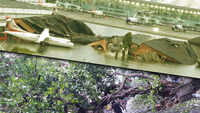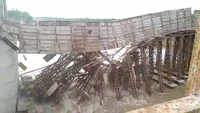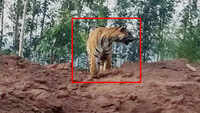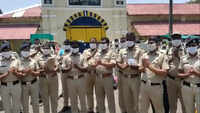
Special relief commissioner P K Jena speaks to Sujit Bisoyi on the challenges of preparing for a cyclone amid the novel coronavirus pandemic. Excerpts:
n How difficult was it to handle a cyclone at this time?
It was a big challenge for the government machinery. Odisha has never experienced the simultaneous occurrence of a natural disaster and a pandemic. The need to observe mandatory norms such as social distancing, wearing of mask and maintenance of personal hygiene was a problem. Since many of the cyclone shelters have been converted into temporary medical camps in view of Covid-19, we asked the collectors to identify alternative structures for evacuation of the people from vulnerable areas. We identified 567 unused cyclone shelters and more than 7,000 other structures for use as temporary shelters for evacuees.
n What steps were taken to maintain social distancing during the evacuation?
We created facilities for the evacuation of 11 lakh people in 12 coastal and adjoining districts, if required. As per the final report, we evacuated around two lakh people. Most of them have returned to their homes by now. To maintain social distancing, we put fewer people in the temporary shelters.
n Did the state government aim at zero casualty this time too?
When we say zero casualty, the idea is to put in place a system to minimise the number of deaths as far as possible. We have received report of one death and are awaiting the postmortem result. We can only comment on the death after we receive the postmortem report. There is no report of any other deaths in the state.
n What is the extent of the damage caused?
We have received report of damages to kutcha houses, standing crop and power infrastructure. The collectors have been asked to submit final reports within 48 hours. The impact was not as severe as we had prepared for, since the cyclone passed around 120 km east of Paradip. We left no stone unturned in terms of preparations, however, as the Met department said it would be a super cyclone. Deployment of response teams was done accordingly. This helped in quick restoration.
n PM Narendra Modi appreciated the response of the officials
The administration worked as a team to face the cyclone. All the concerned departments used their resources strategically. The collectors worked very hard in terms of evacuation and pre-positioning of response teams of NDRF, ODRAF and fire services. Our learning from past cyclones helped us a lot in tackling this disaster effectively. I was in constant touch with IMD DG Mrutyunjay Mohapatra and his team here. Their prediction was precise, which helped us a lot.
n What lessons have you learnt as a result of the simultaneous disasters?
We have started a detailed process to document our response to this strong natural disaster in the middle of a pandemic. We will feature all our efforts, learning and mistakes (if any) as part of the documentation. It may help other states and countries learn a lot.
n Will the government request for assistance from the National Disaster Response Fund?
Let the collectors submit the damage assistance reports first. We will compile them and then take a call. So far, no decision has been taken on submitting a report to the Centre for assistance form the fund.
n How difficult was it to handle a cyclone at this time?
It was a big challenge for the government machinery. Odisha has never experienced the simultaneous occurrence of a natural disaster and a pandemic. The need to observe mandatory norms such as social distancing, wearing of mask and maintenance of personal hygiene was a problem. Since many of the cyclone shelters have been converted into temporary medical camps in view of Covid-19, we asked the collectors to identify alternative structures for evacuation of the people from vulnerable areas. We identified 567 unused cyclone shelters and more than 7,000 other structures for use as temporary shelters for evacuees.
n What steps were taken to maintain social distancing during the evacuation?
We created facilities for the evacuation of 11 lakh people in 12 coastal and adjoining districts, if required. As per the final report, we evacuated around two lakh people. Most of them have returned to their homes by now. To maintain social distancing, we put fewer people in the temporary shelters.
n Did the state government aim at zero casualty this time too?
When we say zero casualty, the idea is to put in place a system to minimise the number of deaths as far as possible. We have received report of one death and are awaiting the postmortem result. We can only comment on the death after we receive the postmortem report. There is no report of any other deaths in the state.
n What is the extent of the damage caused?
We have received report of damages to kutcha houses, standing crop and power infrastructure. The collectors have been asked to submit final reports within 48 hours. The impact was not as severe as we had prepared for, since the cyclone passed around 120 km east of Paradip. We left no stone unturned in terms of preparations, however, as the Met department said it would be a super cyclone. Deployment of response teams was done accordingly. This helped in quick restoration.
n PM Narendra Modi appreciated the response of the officials
The administration worked as a team to face the cyclone. All the concerned departments used their resources strategically. The collectors worked very hard in terms of evacuation and pre-positioning of response teams of NDRF, ODRAF and fire services. Our learning from past cyclones helped us a lot in tackling this disaster effectively. I was in constant touch with IMD DG Mrutyunjay Mohapatra and his team here. Their prediction was precise, which helped us a lot.
n What lessons have you learnt as a result of the simultaneous disasters?
We have started a detailed process to document our response to this strong natural disaster in the middle of a pandemic. We will feature all our efforts, learning and mistakes (if any) as part of the documentation. It may help other states and countries learn a lot.
n Will the government request for assistance from the National Disaster Response Fund?
Let the collectors submit the damage assistance reports first. We will compile them and then take a call. So far, no decision has been taken on submitting a report to the Centre for assistance form the fund.

Coronavirus outbreak
Trending Topics
LATEST VIDEOS
City
 Cyclone Amphan: 6 hours of fury that devastated parts of Kolkata
Cyclone Amphan: 6 hours of fury that devastated parts of Kolkata  On cam: Under-construction bridge collapses in Odisha's Balasore
On cam: Under-construction bridge collapses in Odisha's Balasore  Tiger spotted near coal mine in Telangana's Komaram Bheem district, video goes viral
Tiger spotted near coal mine in Telangana's Komaram Bheem district, video goes viral  Cops chant Bharat Mata Ki Jai, as they step out after 21-day lockdown duty in Nagpur central jail
Cops chant Bharat Mata Ki Jai, as they step out after 21-day lockdown duty in Nagpur central jail
More from TOI
Navbharat Times
Featured Today in Travel
Quick Links
Kerala Coronavirus Helpline NumberHaryana Coronavirus Helpline NumberUP Coronavirus Helpline NumberBareilly NewsBhopal NewsCoronavirus in DelhiCoronavirus in HyderabadCoronavirus in IndiaCoronavirus symptomsCoronavirusRajasthan Coronavirus Helpline NumberAditya ThackerayShiv SenaFire in MumbaiAP Coronavirus Helpline NumberArvind KejriwalJammu Kashmir Coronavirus Helpline NumberSrinagar encounter
Get the app



